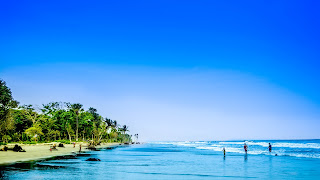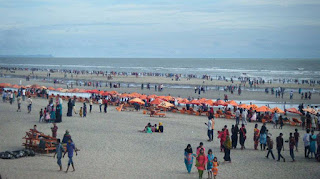 |
| Phuket Thailand |
Phuket (Thai: ภูเก็ต, বাংলা [ফুকেট]) is one of the southern regions (changwat) of Thailand. It comprises of the island of Phuket, the nation's biggest island, and another 32 littler islands off its coast. It lies off the west bank of Thailand in the Andaman Sea. Phuket Island is joined by scaffold to Phang Nga Province toward the north. The following closest region is Krabi, toward the east crosswise over Phang Nga Bay.
Phuket Province has a territory of 576 square kilometers (222 sq mi), to some degree not exactly that of Singapore, and is the second-littlest area of Thailand. It in the past got its riches from tin and elastic, and appreciates a rich and beautiful history. The island was on one of the real exchanging courses in the middle of India and China, and was as often as possible specified in remote boat logs of Portuguese, French, Dutch, and English merchants. The district now derives much of its income from tourism.
Phuket Province has a territory of 576 square kilometers (222 sq mi), to some degree not exactly that of Singapore, and is the second-littlest area of Thailand. It in the past got its riches from tin and elastic, and appreciates a rich and beautiful history. The island was on one of the real exchanging courses in the middle of India and China, and was as often as possible specified in remote boat logs of Portuguese, French, Dutch, and English merchants. The district now derives much of its income from tourism.
Name:
The generally late name "Phuket" (of which the digraph ph speaks to a suctioned p) is obviously gotten from the word bukit (Jawi: بوكيت) in Malay which signifies "slope", as this is the thing that the island seems like from a separation. An option recommendation is that the name begins from two Thai words, "phu" (mountain) of "ket" (gem), and this is said to be recorded in a Thai annal.
Phuket was in the past known as Thalang (ถลาง Tha-Laang), got from the old Malay "telong" (Jawi: تلوڠ) which signifies "cape". The northern locale of the territory, which was the area of the old capital, still uses this name. In Western sources and route outlines, it was known as Jung Ceylon (a debasement of the Malay Tanjung Salang, i.e.
Phuket was in the past known as Thalang (ถลาง Tha-Laang), got from the old Malay "telong" (Jawi: تلوڠ) which signifies "cape". The northern locale of the territory, which was the area of the old capital, still uses this name. In Western sources and route outlines, it was known as Jung Ceylon (a debasement of the Malay Tanjung Salang, i.e.
The Seal of Phuket:
 |
| Phuket Thailand |
The seal is a delineation of the Thao Thep Kasatri and Thao Sri Sunthon Heroines Monument. These ladies shielded the territory from the Burmese in 1785 CE. In 1785 Burmese troops were get ready to assault Phuket. Its military representative had recently passed on, accordingly the Burmese thought the island could be effortlessly seized. In any case, Khun Jan, the dowager of the expired representative and her sister, Khun Mook, requested the ladies of the island to dress as troopers and take positions on the Thalang city dividers. The Burmese canceled their assault because of the apparent quality of the guards. Shy of sustenance, they withdrew. The two ladies got to be neighborhood courageous women. They got the privileged titles, Thao Thep Kasatri and Thao Sri Sunthon, from King Rama I.
The seal is a circle encompassed by a ka–nok line that demonstrates the valiance of pioneers in Phuket Province. The seal has been utilized subsequent to 1985.
The seal is a circle encompassed by a ka–nok line that demonstrates the valiance of pioneers in Phuket Province. The seal has been utilized subsequent to 1985.
History:
 |
| Phuket Island |
In the seventeenth century, the Dutch, English and, after the 1680s, the French, sought the chance to exchange with the island of Phuket (then known as "Jung Ceylon"), which was a rich wellspring of tin. In September 1680, a boat of the French East India Company went by Phuket and left with a full load of tin.
A year or two later, the Siamese King Narai, trying to decrease Dutch and English impact, named as legislative head of Phuket a French restorative teacher, Brother René Charbonneau, an individual from the Siam mission of the Société des Missions Etrangères. Charbonneau stayed as representative until 1685.
In 1685, King Narai affirmed the French tin imposing business model in Phuket to their represetative, the Chevalier de Chaumont. Chaumont's previous maître d'hôtel, Sieur de Billy, was named legislative head of the island. Be that as it may, the French were removed from Siam after the 1688 Siamese upset. On 10 April 1689, Desfarges drove a campaign to re-catch Phuket to restore French control in Siam. His control of the island prompted nothing, and Desfarges came back to Puducherry in January 1690.
The Burmese assaulted Phuket in 1785. Francis Light, a British East India Company skipper going by the island, advised the neighborhood organization that he had watched Burmese powers get ready to assault. Than Phu Ying Chan, the wife of the as of late perished senator, and her sister Mook (คุณมุก) gathered what neighborhood strengths they could. Following a month-long attack of the capital city, the Burmese were compelled to withdraw on 13 March 1785. The ladies got to be neighborhood courageous women, accepting the regal titles Thao Thep Kasattri and Thao Si Sunthon from an appreciative King Rama I. Amid the rule of King Chulalongkorn (Rama V), Phuket turned into the authoritative focus of the tin-creating southern regions. In 1933 Monthon Phuket (มณฑลภูเก็ต) was broken.
A year or two later, the Siamese King Narai, trying to decrease Dutch and English impact, named as legislative head of Phuket a French restorative teacher, Brother René Charbonneau, an individual from the Siam mission of the Société des Missions Etrangères. Charbonneau stayed as representative until 1685.
In 1685, King Narai affirmed the French tin imposing business model in Phuket to their represetative, the Chevalier de Chaumont. Chaumont's previous maître d'hôtel, Sieur de Billy, was named legislative head of the island. Be that as it may, the French were removed from Siam after the 1688 Siamese upset. On 10 April 1689, Desfarges drove a campaign to re-catch Phuket to restore French control in Siam. His control of the island prompted nothing, and Desfarges came back to Puducherry in January 1690.
The Burmese assaulted Phuket in 1785. Francis Light, a British East India Company skipper going by the island, advised the neighborhood organization that he had watched Burmese powers get ready to assault. Than Phu Ying Chan, the wife of the as of late perished senator, and her sister Mook (คุณมุก) gathered what neighborhood strengths they could. Following a month-long attack of the capital city, the Burmese were compelled to withdraw on 13 March 1785. The ladies got to be neighborhood courageous women, accepting the regal titles Thao Thep Kasattri and Thao Si Sunthon from an appreciative King Rama I. Amid the rule of King Chulalongkorn (Rama V), Phuket turned into the authoritative focus of the tin-creating southern regions. In 1933 Monthon Phuket (มณฑลภูเก็ต) was broken.







